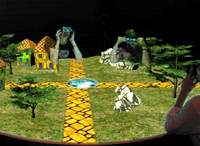 I still have to deliver a report on some other interesting installations at Ars Electronica. One of them is called Gulliver‘s Box.
I still have to deliver a report on some other interesting installations at Ars Electronica. One of them is called Gulliver‘s Box.
The setup consists of a round and empty table. The basic idea is that the table is a virtual space where you can put objects on. To view these objects and their virtual environment, you put on one of three 3D goggles. A computer tracks your viewpoint and you see the virtual scenery instead of the empty table.
In a shelf you find some transparent boxes. Behind the box is a display and you can see one of eight moving characters on them, supposedly living in the box. Here‘s the scoop: you take out the box, put in on the table, and you see the virtual character in the virtual scenery – in the box.
You can open the box (a lid moves) and the character jumps out, eventually interacting with other characters. Very nice shapes, nice movements, carefully designed. The resolution could be better, but I was told this was to leave room for including hi-res 3D scans of people that could be placed in the box instead. Unfortunately, this feature is not yet completed.
The system detects the state of the lid (open/closed) by use of firewire-coupled CCD cameras from above. An array of infrared LCDs provides the necessary lighting that can be reliably distinguished from other light sources. The lid has a certain symbol on top (closed) and underneath (open), so it is easy for the computer to track the state. The same system also tracks position and orientation of the box.
A projector produces a bright background light on the table from the center of the table to a mirror above and back on the table‘s surface. it is used to produce a real-world shadow of the virtual character. Really nice.
The whole system suffers a bit from the jittery behaviour of the 3D goggles (a software smoothener is needed) but basically everything has been done right. A cool project.
